|
|
|
Sort Order |
|
|
|
Items / Page
|
|
|
|
|
|
|
| Srl | Item |
| 1 |
ID:
143657
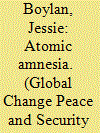

|
|
|
|
|
| Summary/Abstract |
This paper addresses the ways in which photography can illuminate that which is unfathomable, such as nuclear catastrophe. It discusses how chronicling the nuclear era through art can allow us to break free of our atomic amnesia and urge us to imagine possible alternative futures free of nuclear disaster. It examines the ways in which members of the Atomic Photographers Guild have sharply focused on all aspects of the nuclear age and its fallout.
|
|
|
|
|
|
|
|
|
|
|
|
|
|
|
|
| 2 |
ID:
143655
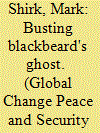

|
|
|
|
|
| Summary/Abstract |
Despite renewed interest, one area of piracy studies that can be improved is that of historical comparison. Most studies operate under the belief that piracy is an action similar enough to be compared across time and space. Yet piracy is a socially constructed concept that only has meaning within a narrative and most ‘waves’ of piracy are characterized by more than one narrative. Thus, comparing all acts of piracy across time and space necessarily means accepting a particular narrative about piracy as true. Much historical-comparative work on piracy compares contemporary piracy to that of the ‘golden age’ of piracy in the eighteenth century. By focusing on the narratives of both pirates and counter-pirates, piracy in Southeast Asia in the nineteenth century is more comparable to contemporary piracy in the Gulf of Aden. Both ‘waves’ were characterized by competing narratives of pirates defending local interests vs. the counter-piracy narratives of criminality. This approach highlights similar dynamics in each that can help researchers and policymakers make sense of piracy in the twenty-first century. In particular both ‘waves’ were characterized by the rise of local political formations built around piracy and the denial of the political content of piracy by counter-pirates.
|
|
|
|
|
|
|
|
|
|
|
|
|
|
|
|
| 3 |
ID:
143659
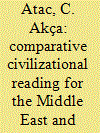

|
|
|
|
|
| Summary/Abstract |
The 1990s witnessed a bloom of studies on the ‘standard of civilization', which all aimed to explore the future of the rift between the East and the West. The Arab Spring and its implications for the primordial competition between the East and the West has once again required the revisiting of certain, rather more contemporary, theoretical aspects of the grand debate on civilization. This paper aims to introduce current arguments pertaining to the grand debate on civilization into the context of the Arab Spring. In doing so, it seeks to offer a comparative perspective of the quest for understanding the current situation in the Middle East with particular reference to the civilization discourse which is currently on the rise in Turkish politics. Turkey is among the actors in the Middle East seeking to assume leadership in order to establish peace in the region.
|
|
|
|
|
|
|
|
|
|
|
|
|
|
|
|
| 4 |
ID:
143656
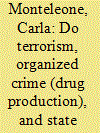

|
|
|
|
|
| Summary/Abstract |
In 2014, the UN Security Council emphasized the dangers of terrorism, criminal activity (especially drug production and trafficking), and state weakness in conflict areas. However, neither policy debates nor scholarly analyses have focussed on the potential impact of these elements on conflict dynamics and characteristics, and the investigated partial relationships have led to inconclusive results. This article explores the presence in armed conflicts of terrorist groups among fighting parties, major drug production (indicating the presence of activities typical of criminal organizations), and state failure in the period 1990–2011. Focussing on intrastate conflicts, this article highlights that, while when they are isolated their impact on armed conflicts is limited, when the three factors are simultaneously present, the interactions among them create a sort of threshold effect capable of affecting conflict characteristics and, in particular, conflict duration and incompatibility.
|
|
|
|
|
|
|
|
|
|
|
|
|
|
|
|
| 5 |
ID:
143660
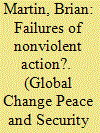

|
|
|
|
|
| Summary/Abstract |
Thomas Richard Davies in his 2014 article ‘The Failure of Strategic Nonviolent Action in Bahrain, Egypt, Libya and Syria’ in Global Change, Peace & Security addresses an important topic.1 As he notes, there are many lessons to be learned from failures of nonviolent struggles, but far more attention is given to successes. Davies analyses the 2011 nonviolent campaigns in four countries, diagnoses four corresponding modes of failure, and argues that in each of them nonviolent action may contribute to its own failure. Specifically, he argues that in Bahrain nonviolent action made resisters vulnerable to repression, in Egypt the nonviolent campaigners' strategy of alignment with the military made subsequent military repression easier, in Libya the repression of nonviolent resisters generated international outrage, making external military intervention easier to justify, and in Syria nonviolent action contributed to splits in the military, encouraging a transition to armed struggle.
|
|
|
|
|
|
|
|
|
|
|
|
|
|
|
|
| 6 |
ID:
143654
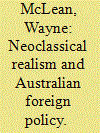

|
|
|
|
|
| Summary/Abstract |
This article uses neoclassical realism to explore how foreign policy elites in Australia frame domestic debates so as to prevent certain ideas interfering with security responses. It does this by presenting a typology that seeks to understand elite dynamics in Australia by capturing three different elite responses – dilution, deflection and inflation. Taken together, these explain how elites mitigate potentially problematic domestic policy contests by pulling ideas towards the centre of debates, and marginalizing others, depending on the issue involved.
|
|
|
|
|
|
|
|
|
|
|
|
|
|
|
|
| 7 |
ID:
143661
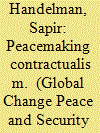

|
|
|
|
|
| Summary/Abstract |
This paper presents a contractual approach to coping with difficult situations of intractable conflict where ordinary citizens are at the center of the struggle. The contractualist peacemaker challenge is to convert conflicting parties into a peacemaking community committed to resolving the conflict by peaceful means. Three main elements are necessary to transform conflicting groups into a peacemaking community: common interest: strong desire to resolve the conflict by peaceful means; rules: commitment to democratic principles of dialogue; and peacemaking institutions: an organizational device that operates and maintains peacemaking communities. A peacemaking institution that has the potential to create momentum for the establishment of a peacemaking community is a major public negotiating congress. An ideal congress invites delegations from all walks of life to negotiate solutions to the conflict. This vision is based on the multi-party talks of the 1990s that helped to create a major change in two difficult situations of intractable conflict: the ‘troubles' in Northern Ireland and the battle against the Apartheid system in South Africa. This paper explores possibilities to establish a major Israeli–Palestinian public negotiating congress.
|
|
|
|
|
|
|
|
|
|
|
|
|
|
|
|
| 8 |
ID:
143658


|
|
|
|
|
| Summary/Abstract |
When Malaysia Airlines Flight MH370 disappeared from radar screens in the early hours of 8 March 2014, initial reactions suggesting that it was just another airliner disaster proved only partially correct. This article offers the interpretation that the multinational search effort for the missing Malaysian Boeing 777-200 airliner was revelatory of an abridged form of security competition among the mostly Pacific Rim states participating in both the post mortem and the search and rescue (SAR) operations. Although the Asia Pacific peace has been largely unbroken since the end of the Cold War, security competition among great powers, middle powers and weak states is still ongoing. In fact, this security competition is taking on proxy forms given the relative robustness of the overlapping architecture of Pacific Rim security regionalism in tamping down pressures for overt armed conflict to advance national security interests. MH370, following in the wake of the destruction wrought by natural disasters since the early 2000s, has provoked a competition in technological prowess in SAR operations, and more broadly, in quasi-civilian humanitarian assistance and disaster relief (HADR) capabilities amongst Pacific Rim states that have overlapping claims on the South China Sea and with interests in revising existing patterns of diplomatic order.
|
|
|
|
|
|
|
|
|
|
|
|
|
|
|
|
|
|
|
|
|